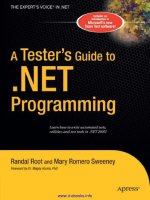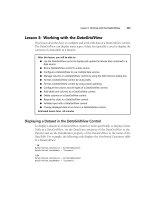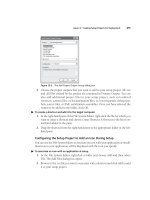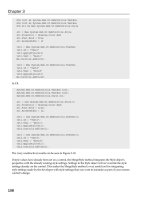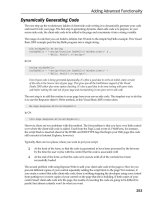Programming Java 2 Micro Edition on Symbian OS A developer’s guide to MIDP 2.0 phần 10 pptx
Bạn đang xem bản rút gọn của tài liệu. Xem và tải ngay bản đầy đủ của tài liệu tại đây (401.04 KB, 50 trang )
422 THE MARKET, THE OPPORTUNITIES AND SYMBIAN’S PLANS
• network bandwidth will improve, though not so dramatically
• network connections will always be available, reducing latency
• costs for persistent storage will continue to tumble and access speeds
will increase dramatically as new memory technologies, such as
Ferroelectric RAM, Magnetic RAM and Ovonic memory, replace
NOR and NAND flash
• the resolution of screen displays will continue to improve, through a
decrease in dot pitch as screen sizes will be limited by overall mobile
phone ergonomics.
There will also be market changes:
• ”smart houses” will become a reality: climate control, entertainment
and security systems will be controlled by a variety of devices,
including mobile phones
• digital consumer goods will converge.
Today, video cameras can take still images and digital cameras can record
video, and quite often both include MP3 players. These capabilities are
moving into mobile phones: the current phones only support VGA,
however the next generation of mobile phones will have megapixel
resolution cameras (indeed a number of Japanese cameras already do).
Many of today’s mobile phones come with FM radios and in the future
we are likely to see the inclusion of Digital Audio Broadcast radios. In
Korea, people can now use their mobile phones for credit card purchases.
The consequence will be an explosion in the amount of data users store
on their mobile phone: audio, video, images, email and messaging. This
will amount to gigabytes of storage.
So, we leave you with a simple challenge: to use your development
skills, and the knowledge and insight that we hope you have gained
from this book, to create the next killer Java service or application on
Symbian OS.
Appendix 1
CLDC Core Libraries
System Classes
java.lang.Class Instances of Class represent classes
and interfaces in a running application.
java.lang.Object The Object class is the root of classes.
java.lang.Runtime Every Java application has a single
instance of the Runtime class, which
allows the application to interface with
the environment in which it is running.
Note that the Exit() method always
throws a java.lang.
SecurityException.
java.lang.System The System class contains several
useful fields and methods and it cannot
be instantiated. Note that the Exit()
method always throws a java.lang.
SecurityException.
java.lang.Thread A Thread is a unit of execution in a
program. Multiple threads may be
executed concurrently.
java.lang.Runnable (interface) This interface should be implemented
by any class which is intended to be
executed as threads. A run() method
must be defined by such a class.
java.lang.Throwable The Throwable class is the superclass
of all errors and exceptions.
Programming Java 2 Micro Edition on Symbian OS: A developer’s guide to MIDP 2.0
. Martin de Jode
2004 Symbian Ltd ISBN: 0-470-09223-8
424 CLDC CORE LIBRARIES
Data Type Classes
java.lang.Boolean The Boolean class wraps a value of
the boolean primitive type in an object.
java.lang.Byte The Byte class wraps a value of the
byte primitive type in an object.
java.lang.Character The Character wraps a value of the
char primitive type in an object.
java.lang.Integer The Integer class wraps a value of
the int primitive type in an object.
java.lang.Long The Long class wraps a value of the
long primitive type in an object.
java.lang.Short The Short class wraps a value of the
short primitive type in an object.
java.lang.String The String class represents character
strings.
java.lang.Stringbuffer A StringBuffer implements a
mutable sequence of characters.
Collection Classes
java.util.Vector The Vector class implements an array
of objects that can grow.
java.util.Stack The Stack class represents a last in
first out stack of objects.
java.util.Hashtable This class implements a hashtable,
which maps keys to values.
java.util.Enumeration (interface) An object that implements the
Enumeration interface generates a
series of elements, one at a time.
Input/Output Classes
java.io.InputStream This abstract class is the superclass of
all classes representing an input stream
of bytes.
java.io.OutputStream This abstract class is the superclass of
all classes representing an output
stream of bytes.
java.io.ByteArrayInputStream A ByteArrayInputStream has an
internal buffer that contains bytes that
may be read from the stream.
CALENDAR AND TIME CLASSES 425
java.io.ByteArrayOutputStream This class implements an output
stream in which the data is written into
a byte array.
java.io.DataInput (interface) The DataInput interface provides for
reading bytes from a binary stream and
reconstructing from them data in any
of the primitive types.
java.io.DataOutput (interface) The DataOutput interface provides
for converting data from any of the
primitive types to a series of bytes and
writing to a binary stream.
java.io.DataInputStream A DataInputStream lets an
application read primitive data types
from an underlying input stream in a
machine-independent way.
java.io.DataOutputStream A DataOutputStream lets an
application write primitive data types
to an output stream in a portable way.
java.io.Reader An abstract class for reading character
streams.
java.io.Writer An abstract class for writing character
streams.
java.io.InputStreamReader An InputStreamReader is a bridge
from byte streams to character streams.
It reads bytes and translates them into
characters according to a specified
character encoding.
java.io.OutputStreamReader An OutputStreamReader is a
bridge from character streams to byte
streams. Characters written to it are
translated into bytes according to a
specified character encoding.
java.io.PrintStream A PrintStream adds functionality to
another output stream, namely the
ability to print representations of
various data values conveniently.
Calendar and Time Classes
java.util.Calendar The Calendar is an abstract class for
getting and setting dates using a set of
integer fields such as YEAR, MONTH,
DAY, etc.
426 CLDC CORE LIBRARIES
java.util.Date The Date class represents a specific
instant in time with a millisecond
precision.
java.util.TimeZone The TimeZone class represents a time
zone offset and also works out daylight
savings.
Additional Utility Classes
java.util.Random An instance of this class is used to
generate series of pseudo-random
numbers.
java.lang.Math The Math class contains methods for
performing basic numeric operations.
Exception Classes
java.lang.Exception The Exception class and its
subclasses are a form of Throwable
that indicates conditions that a
reasonable application might want to
catch.
java.lang.ClassNotFoundException Thrown when an application tries to
load in a class through its string name
using the forName() method in
Class class.
java.lang.IllegalAccessException Thrown when an application tries to
load in a class but the executing
method does not have access to the
class definition, because the class is in
another package and is not public.
java.lang.InstantiationException Thrown when an application tries to
create an instance of a class using the
newInstance() method in Class
class, but cannot instantiate it because
it is an interface or an abstract class or
it doesn’t have a default constructor.
java.lang.InterruptedException Thrown when a thread is waiting,
sleeping or otherwise paused and
another thread interrupts it.
java.lang.RuntimeException This is the superclass of exceptions that
can be thrown during the normal
operation of the Java Virtual Machine.
EXCEPTION CLASSES 427
java.lang.ArithmeticException Thrown when an exceptional
arithmetic condition occurs.
java.lang.ArrayStoreException Thrown to indicate that an attempt has
been made to store the wrong type of
object in an array of objects.
java.lang.
ArrayIndexOutOfBoundsException
Thrown to indicate that an array has
been accessed with an illegal index.
java.lang.ClassCastException Thrown to indicate that the code has
attempted to cast an object to a
subclass of which it is not an
instance.
java.lang.
IllegalArgumentException
Thrown to indicate that a method has
been passed an illegal or inappropriate
argument.
java.lang.
IllegalThreadStateException
Thrown when starting a Thread for
the second time.
java.lang.NumberFormatException Thrown when trying to read an
Integer from a malformed String.
java.lang.
IllegalMonitorStateException
Thrown to indicate that a thread has
attempted to wait on an object’s
monitor or to notify other threads
waiting on an object’s monitor without
owning the specified monitor.
java.lang.
IndexOutofBoundsException
Thrown to indicate that an index of
some sort (such as an index to an
array, to a string, or to a vector) is out
of range.
java.lang.
StringIndexOutOfBoundsException
Thrown by the charAt() method in
class String and by other String
methods, to indicate that an index is
either negative or greater than or equal
to the size of the string.
java.lang.
NegativeArraySizeException
Thrown if an application tries to create
an array with negative size.
java.lang.NullPointerException Thrown when an application attempts
to use null in a case where an object is
required.
java.lang.SecurityException Thrown by the security manager to
indicate a security violation.
java.util.EmptyStackException Thrown by methods in the Stack class
to indicate that the stack is empty.
java.util.NoSuchElementException Thrown by the methods of an
Enumeration to indicate that there
are no more elements in the
enumeration.
428 CLDC CORE LIBRARIES
java.io.EOFException Signals that an end of file or end of
stream has been reached unexpectedly
during input.
java.io.IOException Signals that an I/O exception of some
sort has occurred.
java.io.InterruptedIOException Signals that an I/O operation has been
interrupted.
java.io.
UnsupportedEncodingException
Signals that the character encoding is
not supported.
java.io.UTFDataFormatException Signals that a malformed UTF8 string
has been read in a data input stream or
by any class that implements the data
input interface.
Error Classes
In contrast to the exception classes, the error-handling capabilities of
CLDC are limited to just three:
java.lang.Error Error is a subclass of Throwable
that indicates serious problems that a
reasonable application may not try to
catch.
java.lang.VirtualMachineError Thrown to indicate that the Java Virtual
Machine is broken or has run out of
the resources necessary for it to
continue operating.
java.lang.OutOfMemoryError Thrown when the Java Virtual
Machine cannot allocate an object
because it is out of memory and no
more memory can be made available
by the garbage collector.
Catching an OutOfMemoryError is very good practice when devel-
oping for a resource-constrained device. It allows the developer to try
to free all the memory he can and maybe give the application another
chance to perform the requested action. In the worst case scenario, the
application should be able to display a previously allocated dialog box
to inform the user that the application cannot continue.
Appendix 2
MIDP Libraries
Networking Package
javax.microedition.io.Connection This interface is the most
basic type of generic
connection.
javax.microedition.io.Connector This class is a placeholder for
the static methods used to
create all the connection
objects.
javax.microedition.io.CommConnection This interface defines a
logical serial port connection.
javax.microedition.io.ContentConnection This interface defines the
stream connection over
which content is passed.
javax.microedition.io.Datagram This is the generic datagram
interface.
javax.microedition.io.DatagramConnection This interface defines the
capabilities that a datagram
connection must have.
javax.microedition.io.HttpConnection This interface defines the
necessary methods and
constants for an HTTP
connection.
javax.microedition.io.HttpsConnection This interface defines the
necessary methods and
constants to establish a secure
network connection.
javax.microedition.io.InputConnection This interface defines the
capabilities that an input
stream connection must have.
Programming Java 2 Micro Edition on Symbian OS: A developer’s guide to MIDP 2.0
. Martin de Jode
2004 Symbian Ltd ISBN: 0-470-09223-8
430 MIDP LIBRARIES
javax.microedition.io.OutputConnection This interface defines the
capabilities that an output
stream connection must have.
javax.microedition.io.PushRegistry This class maintains a list of
inbound connections.
javax.microedition.io.SecureConnection This interface defines the
secure socket stream
connection.
javax.microedition.io.SecurityInfo This interface defines the
methods for accessing
information about a secure
connection.
javax.microedition.io.
ServerSocketConnection
This interface defines the
server socket stream
connection.
javax.microedition.io.SocketConnection This interface defines the
socket stream connection.
javax.microedition.io.StreamConnection This interface defines the
capabilities that a stream
connection must have.
javax.microedition.io.
StreamConnectionNotifier
This interface defines the
capabilities that a connection
notifier must have.
javax.microedition.io.
UDPDatagramConnection
This interface defines a
datagram connection which
knows the local end point
address.
Exception
javax.microedition.io.
ConnectionNotFoundException
Signals that the protocol for
the connection is not
supported by the device.
User Interface Classes
javax.microedition.lcdui.Alert A screen that shows data to
the user and waits for a
certain period of time
before proceeding to the
next screen.
javax.microedition.lcdui.AlertType Provides an indication of
thenatureofalerts.
USER INTERFACE CLASSES 431
javax.microedition.lcdui.Canvas The base class for writing
applications that need to
handle low-level events
andtoissuegraphics
calls for drawing to the
display.
javax.microedition.lcdui.Choice This interface defines an API
for user interface components
that enable the user to select
from a predefined number of
choices.
javax.microedition.lcdui.ChoiceGroup A group of selectable
elements intended to be
placed within a Form.
javax.microedition.lcdui.Command A construct that encapsulates
the semantic information of
an action.
javax.microedition.lcdui.CommandListener This interface is used by
applications which need to
receive high-level events from
the implementation.
javax.microedition.lcdui.CustomItem A customizable element
which can be subclassed to
introduce new visual and
interactive elements to a
Form.
javax.microedition.lcdui.DateField An editable component for
presenting date and time
(calendar) information that
may be placed in a Form.
javax.microedition.lcdui.Display Represents the manager of the
display and GUI capabilities
of the system.
javax.microedition.lcdui.Displayable An object that can be placed
on the display.
javax.microedition.lcdui.Font Represents fonts and font
metrics.
javax.microedition.lcdui.Form A Screen that contains an
arbitrary mixture of items:
read-only text fields, editable
text fields, editable date
fields, gauges, choice groups
and custom items.
432 MIDP LIBRARIES
javax.microedition.lcdui.Gauge Implements a graphical
display, such as a bar graph,
of an integer value.
javax.microedition.lcdui.Graphics Provides simple 2D geometric
rendering capability.
javax.microedition.lcdui.Image Used to hold graphical image
data.
javax.microedition.lcdui.ImageItem An Item that contains an
image.
javax.microedition.lcdui.Item A superclass for components
that can be added to a
Form.
javax.microedition.lcdui.
ItemCommandListener
This interface is a listener type
for receiving notification of
commands that have been
invoked on Item objects.
javax.microedition.lcdui.
ItemStateListener
This interface is used by
applications which need to
receive events that indicate
changes in the internal state of
the interactive items within a
Form screen.
javax.microedition.lcdui.List A screen containing a list of
choices.
javax.microedition.lcdui.Screen The common superclass of all
high-level user interface
classes.
javax.microedition.lcdui.Spacer A blank, non-interactive Item
that has a settable minimum
size.
javax.microedition.lcdui.StringItem A non-interactive Item that
can contain a string.
javax.microedition.lcdui.TextBox A screen that allows the user
to enter and edit text.
javax.microedition.lcdui.TextField An editable text component
that may be placed in a Form.
javax.microedition.lcdui.Ticker Implements a ”ticker tape”, a
piece of text that runs
continuously across the
display.
Game API
java.microedition.lcdui.game.GameCanvas This class provides the basis
for a game user interface.
MIDLET CLASSES 433
java.microedition.lcdui.game.Layer An abstract class
representing a visual
element of a game.
java.microedition.lcdui.game.
LayerManager
The LayerManager
manages a series of Layers.
java.microedition.lcdui.game.Sprite A basic visual element that
can be rendered with one
of several frames stored in
an image; different frames
can be shown to animate
the Sprite.
java.microedition.lcdui.game.TiledLayer A visual element composed
of a grid of cells that can be
filled with a set of tile
images.
Media API
java.microedition.media.Control A superclass for objects
used to control some media
processing functions.
java.microedition.media.Controllable An interface for obtaining
the Controls from an
object.
java.microedition.media.Manager The access point for
obtaining
system-dependent
resources such as Players
for multimedia processing.
java.microedition.media.MediaException Indicates an unexpected
error condition in a
method.
java.microedition.media.Player Controls the rendering of
time-based media data.
java.microedition.media.PlayerListener An interface for receiving
asynchronous events
generated by Players.
java.microedition.media.control.
ToneControl
An interface that enables
the playback of
user-defined monotonic
tone sequences.
java.microedition.media.control.
VolumeControl
An interface for
manipulating the audio
volume of a Player.
434 MIDP LIBRARIES
Midlet Classes
javax.microedition.midlet.Midlet Superclass for all MIDP
applications.
javax.microedition.midlet.Midlet.
StateChangeException
Signals that a requested
MIDlet state change failed.
Persistent Storage
javax.microedition.rms.
InvalidRecordIDException
Thrown to indicate an
operation could not be
completed because the
record ID was invalid.
javax.microedition.rms.RecordComparator An interface used to
compare two records. An
implementation checks
whether they match or what
their relative sort order is.
javax.microedition.rms.RecordEnumeration An interface representing a
bi-directional record store
record enumerator.
javax.microedition.rms.RecordFilter An interface used to filter
records matching a
criterion
javax.microedition.rms.RecordListener A listener interface for
receiving record changed,
added or deleted events
from a RecordStore.
javax.microedition.rms.RecordStore A class representing a
record store.
javax.microedition.rms.
RecordStoreException
Thrown to indicate a
general exception was
encountered in a
RecordStore operation.
javax.microedition.rms.
RecordStoreFullException
Thrown to indicate that the
operation could not be
completed because the
RecordStore is full.
javax.microedition.rms.
RecordStoreNotFoundException
Thrown to indicate that the
RecordStore could not
be found.
javax.microedition.rms.
RecordStoreNotOpenException
Thrown to indicate that the
operation was attempted on
aclosedRecordStore.
CORE PACKAGES 435
End-to-End Security
java.microedition.pki.Certificate Interface common to
certificates.
java.microedition.pki.
CertificateException
Encapsulates an error that
occurred while a certificate
is being used.
Core Packages
java.io Provides the system input
and output through data
streams and serialization.
java.lang Provides the classes that are
fundamental to the design
of the Java language. For
example, Object,whichis
the root of the class
hierarchy.
java.lang.ref Provides the reference
object classes, which
support a limited degree of
interaction with the
garbage collector.
java.lang.reflect Provides the classes and
interfaces for obtaining
reflective information
about classes and
objects.
java.math Provides classes for
performing
arbitrary-precision integer
(BigInteger) and decimal
arithmetic (BigDecimal).
java.net Provides classes for
implementing networking
applications.
java.security Provides classes and
interfaces for the security
framework.
java.security.cert Provides classes and
interfaces for parsing and
managing certificates.
436 MIDP LIBRARIES
java.text Provides classes and
interfaces for handling text,
dates, numbers and
messages in a manner
independent of natural
languages.
java.util Provides classes which
contain the collections
framework, legacy
collection classes, event
model, date and time
facilities,
internationalization and
miscellaneous utility classes
such as string tokenizer and
random number generator.
java.util.jar Provides classes for reading
and writing the JAR file
format, which is based
upon standard ZIP file
format with an optional
manifest file.
java.util.zip Provides classes for reading
and writing the standard
ZIP and GZIP file formats.
javax.microedition.io Provides classes for the
generic connection
framework.
Appendix 3
Using the Wireless Toolkit Tools
at the Command Line
This appendix provides developers with an insight into how the compile,
pre-verify and packaging process works when using the Wireless Toolkit
at the command line.
In the first instance we should make sure we have all the relevant
binaries within the view of our command line. Some paths, therefore, need
to be set. Assuming the J2ME Wireless Toolkit 2.1 has been installed to
C:\WTK21 we should set the development platform’s PATH environment
variable to that directory. On a Windows desktop computer, the path to
the binaries should be set as follows:
C:> SET PATH=%PATH%;<install dir>\WTK21\bin
We will also need a Java compiler. We should already have the latest
J2SE SDK installed on the machine, so we can use that compiler. Set
PATH as follows:
C:> SET PATH=%PATH%;<install dir>\JavaSoft\j2sdk1.4.2\bin
Now we should be able to use both the compiler and pre-verifier quite
easily. However, before we proceed we should also add a couple of
environment variables to make MIDlet creation a little easier. We need to
direct the commands towards the MIDP API and the other J2ME classes.
Therefore we should set the following variables:
C:> SET J2MEHOME=<install dir>\WTK21
C:> SET MIDPAPI=%J2MEHOME%\lib\midpapi20.jar
C:> SET J2MECLASSPATH=%J2MEHOME%\wtklib\kenv.zip;
%J2MEHOME%\wtklib\kvem.jar;%J2MEHOME%\wtklib\lime.jar;
%J2MEHOME%\lib\cldcapi10.jar
Programming Java 2 Micro Edition on Symbian OS: A developer’s guide to MIDP 2.0
. Martin de Jode
2004 Symbian Ltd ISBN: 0-470-09223-8
438 USING THE WIRELESS TOOLKIT TOOLS AT THE COMMAND LINE
Now that some handy variables have been set, we can try to create
a MIDlet suite. Once the classes have been written, they need to be
compiled. The following command should be used to compile all the
classes in the current directory and then put them in a previously created
directory, tmpclasses. Note that we have specified the classpath of the
MIDP API to make sure the compiler knows to compile against the CLDC
and MIDP classes, otherwise the classes may be compiled against the
J2SE SDK.
C:\WTK20\apps\Example\src>javac -d tmpclasses -bootclasspath %MIDPAPI%
-classpath %J2MECLASSPATH% *.java
Once this has been completed, all the compiled class files can be
seen in the tmpclasses directory. We should now pre-verify them. By
typing the word preverify at the command line the following help
information appears showing the options available.
Usage: preverify [options] classnames|dirnames
where options include:
-classpath <directories separated by ';'> Directories in which to look
for classes
-d <directory> Directory in which output is written (default is
./output/)
-cldc Checks for existence of language features prohibited by
CLDC (native methods, floating point and finalizers)
-nofinalize No finalizers allowed
-nonative No native methods allowed
-nofp No floating point operations allowed
@<filename> Read command line arguments from a text file Command line
arguments must all be on a single line; directory names must be enclosed in
double quotes(")
There are two options of interest to us here. The -classpath option,
which will specify which target API should be verified against, and the -d
option, which specifies the output directory for these verified files. The
following command should be issued in the current directory:
C:\WTK20\apps\Example\src > preverify -classpath %MIDPAPI%;tmpclasses
-d classes tmpclasses
The pre-verified files will now be in the classes directory. These
files are ready for packaging into a MIDlet suite. For this we use the jar
command:
C:\WTK20\apps\Example\src> jar -cvf MyMidlet.jar classes/*
In this case we have asked the jar command to create a JAR file
called MyMidlet.jar from all the files stored in the directory structure
under classes/.
Appendix 4
Developer Resources and Bibliography
Download code for this book from
www.symbian.com/books/pjso/pjso-source.html
Symbian
Corporate
www.symbian.com
Developer
www.symbiandevnet.com
Symbian Licensees
Arima
www.arima.com.tw
BenQ
www.benq.com
Fujitsu
www.fujitsu.com
Lenovo
www.legendgrp.com
LG
Electronics
www.lge.com
Motorola
www.motorola.com
Nokia
www.nokia.com
Panasonic
www.panasonic.com
Psion
www.psion.com
Samsung
www.samsung.com
Sanyo
www.sanyo.com
Sendo
www.sendo.com
Siemens
www.siemens.com
Sony Ericsson
www.sonyericsson.com
Online Developer Resources
Motorola
home.jsp
Nokia
www.forum.nokia.com
Programming Java 2 Micro Edition on Symbian OS: A developer’s guide to MIDP 2.0
. Martin de Jode
2004 Symbian Ltd ISBN: 0-470-09223-8
440 DEVELOPER RESOURCES AND BIBLIOGRAPHY
NTT DoCoMo
www.nttdocomo.com/corebiz/imode/why/tech.html
Sendo
www.sendo.com/dev
Siemens
www.siemens-mobile.com/developer
Sony Ericsson
http//developer.sonyericsson.com
and
www.sonyericsson.com/developer
Sun Microsystems
/>UIQ
www.uiq.com/developer
Tools manufacturers
AppForge
www.appforge.com
Borland
Metrowerks
www.metrowerks.com/MW/Develop/Wireless/Default.htm
Resources Mentioned in This Book and Additional Material
Chapter 1
Java Community Process, JSR 30: CLDC
/>Chapter 2
Antenna
Apache, Jakarta project
Apache, Ant download
/>Apache, Ant project
/>Borland, Jbuilder
www.borland.com/products/downloads/
download
jbuilder.html
Eclipse
www.eclipse.org
RESOURCES MENTIONED IN THIS BOOK AND ADDITIONAL MATERIAL 441
Forum Nokia
www.forum.nokia.com
jEdit
www.jedit.org
Proguard
Retrologic Systems
www.retrologic.com
Sony Ericsson Developer Network, P900 Emulator for the
Wireless Toolkit
http//developer.sonyericsson.com
Sun, J2ME Wireless Toolkit 2.1 Download
1.html
Sun, J2SE downloads
/>Sun ONE Studio 4
www.sun.com/software/sundev/jde/studio me/index.html
Symbian Developer Network, UIQ2.1 SDK
www.symbian.com/developer/sdks uiq21.asp
Xinox Software, Jcreator
www.jcreator.com
Chapter 3
Forum Nokia,
Camera MIDlet: A Mobile Media API Example
/>Forum Nokia,
Known Issues in the Nokia 6600 MIDP 2.0
Implementation
Version 1.2,
www.forum.nokia.com
Java Community Process, JSR 30: CLDC 1.0 specification
/>Java Community Process, JSR 118: MIDP 2.0 specification
/>Java Community Process, JSR 120: Wireless Messaging API specification
/>Java Community Process, JSR 135: Mobile Media API specification
/>Java Community Process, JSR 139: CLDC 1.1 specification
/>Java Community Process, JSR 185: JTWI specification
/>Java Verified Program for J2ME
www.javaverified.com
Sony Ericsson,
Developer Guidelines: Java MIDP 2.0 for P900/908
Version R3A
442 DEVELOPER RESOURCES AND BIBLIOGRAPHY
Sun (2003)
The CLDC HotSpot Implementation Virtual Machine
,
White Paper
Symbian,
Symbian on Java
www.symbian.com/technology/standard-java.html
Symbian Phones
www.symbian.com/phones
Chapter 4
Bluetooth SIG,
Assigned numbers: Bluetooth baseband
/>baseband
Bluetooth SIG,
Specification of the Bluetooth System, Volume 1
.
www.bluetooth.com
Casira Development System for Bluetooth
www.csr.com
Forum Nokia, Nokia Developer’s Suite for J2ME 2.0
Forum Nokia, Series 60 MIDP SDK 1.2.1 for Symbian OS, Nokia Edition
Forum Nokia (2003)
Setting Up and Using the Bluetooth Testing
Environment for Series 60 Platform
Hopkins, B. and Anthony, R. (2003)
Bluetooth for Java
, Apress.
Java Community Process, JSR 82: Java APIs for Bluetooth Wireless
Technology
/>Rococo Impronto Simulator
www.rococosoft.com
Symbian, UIQ 2.1 SDK
www.symbian.com
Chapter 5
kXML library
Nokia, Wireless Toolkit
Proguard Obfuscation Library
Sony Ericsson Developer Network, P900 Emulator for the Wireless
Toolkit
http//developer.sonyericsson.com
RESOURCES MENTIONED IN THIS BOOK AND ADDITIONAL MATERIAL 443
Sun, J2ME Wireless Toolkit 2.1 Download
1.html
Sun, Java Web Services Toolkit
/>Chapter 6
Java Community Process, JSR185: JTWI specification
/>W3, CC/PP information
www.w3.org/Mobile/CCPP
Chapter 7
Allin, J. (2001)
Wireless Java for Symbian Devices
, Wiley.
Buschmann, F., Meunier, R., Rohnert, H., Sommerland, P. and Stal, M.
(1996)
Pattern-Oriented Software Architecture: A system of patterns
,
Wiley.
Embedded Microprocessor Benchmark Consortium, GrinderBench
www.eembc.hotdesk.com
Grand, M. and Knudsen, J. (1997)
Java Fundamental Classes Reference
,
O’Reilly
Haggar, P. (2000)
Practical Java Programming Language Guide
, Addison-
Wesley.
Knuth, D. E. (1997)
The Art of Computer Programming
Addison Wesley.
Larman, C. and Guthrie, R. (1999)
Java 2 Performance and Idiom Guide
.
Prentice Hall.
Lurie, J. (2001)
Develop a Generic Caching Service to Improve Perfor-
mance
, Java World
www.javaworld.com/javaworld/jw-07-2001/jw-0720-
cache
p.html
Nondove, Amark 1.3
Poundstone, W. (1985)
The Recursive Universe: Cosmic complexity and
the limits of scientific knowledge
, William Morrow.
Proguard
Shirazi, J. (2003)
Java Performance Tuning
, O’Reilly.
Sosnoski, D. M. (1999)
Smart Object-management Saves the Day
www.javaworld.com/javaworld/jw-11-1999/jw-11-
performance.html
Chapter 8
ARC Group
www.arcgroup.com
444 DEVELOPER RESOURCES AND BIBLIOGRAPHY
eWeek, Enterprise news and reviews
www.eweek.com/article2/0,4149,893492,00.asp
Java Community Process, JSR 75: PDA Optional Packages for the J2ME
Platform
/>Java Community Process, JSR 135: Mobile Media API
/>Java Community Process, JSR 172: J2METM Web Services Specification
/>Java Community Process, JSR 177: Security and Trust Services API for
J2ME
/>Java Community Process, JSR 179: Location API for J2ME
/>Java Community Process, JSR 180: SIP API for J2ME
/>Java Community Process, JSR 184: Mobile 3D Graphics API for J2ME
/>Java Community Process, JSR 205: Wireless Messaging API 2.0
/>Java Community Process, JSR 211: Content Handler API
/>Java Community Process, JSR 226: Scalable 2D Vector Graphics API for
J2ME
/>Java Community Process, JSR 229: Payment API
/>Java Community Process, JSR 230: Data Sync API
/>Java Community Process, JSR 232: Mobile Operational Management
/>Java Verified Program
www.javaverified.com
Khronos Group, OpenGL ES
www.khronos.org/opengles
Macrospace
www.macrospace.com
O’Doherty, P. (2003)
SIP Specifications and the Java Platforms
,Sun
www.cs.columbia.edu/sip/Java-SIP-Specifications.pdf
OMA DRM Version 1.0, Specification
www.openmobilealliance.org/tech/release.html
OMA DRM Version 1.0, Top-level description
www.openmobilealliance.org/docs/DRM%20Short%
20Paper%20DEC%202003 %20.pdf
Appendix 5
Specifications of Symbian OS Phones
Additional technical information on a range of phones can be found at
www.symbian.com/phones
.
Please note that this is a quick guide to Symbian OS phones. For full
specifications, C++ developers retrieve extended information using HAL
APIs or check the manufacturer’s website.
Programming Java 2 Micro Edition on Symbian OS: A developer’s guide to MIDP 2.0
. Martin de Jode
2004 Symbian Ltd ISBN: 0-470-09223-8
446 SPECIFICATIONS OF SYMBIAN OS PHONES
Nokia 9210i
Java APIs CLDC 1.0
MIDP 1.0
PersonalJava 1.1.1
JavaPhone
OS Version Symbian OS v6.0
UI/Category Series 80
Memory available to user 40 MB
Storage media Yes
Screen 640 × 200; 4096 colors
Pointing device No
Camera No
GSM/HSCSD/GPRS/3G
GSM 900 Yes
GSM 1800 Yes
GSM 1900 No (GSM 900/1900 on 9290)
HSCSD Yes
GPRS No
3G No
Connectivity
Infrared Yes
Bluetooth No
USB No
Serial Yes
Browsing
WAP WAP 1.1
XHTML (MP) Yes
Browser available Yes (built-in and third-party)



